Features & News
Interview: Bruce Roberts Dell @ Unlimited Detail Technology
April 30, 2010, Author: Jacob Saylor
Bruce Roberts Dell is the CEO of a new and uprising technology called Unlimited Detail. It is supposedly the “New thing” when it comes to 3D imaging, and while he loves what polygons have done for the industry, he feels that they are a bit dated and this new technology could possibly be more widely used in the coming years. I got the chance to ask this ambitious man a few questions, and with his busy schedule I feel honored to have even gotten a reply. So, without further ado, here is the interview and all it entails with Mr. Dell.
Q. For anyone reading this article who may not know what Unlimited Detail Technology is, in a nutshell, what is it?
“Its job is to find one atom for every pixel on the screen and not touch any of the others, it took us fifteen years to perfect the technique (it began as a hobby). What we have now works very well. We are able to display pictures with no geometry limitations at 24-30 fps 1024*600, one core with out any graphics hardware assistance, and we have only just begun to optimize so we are hoping to double that without any hardware assistance.”
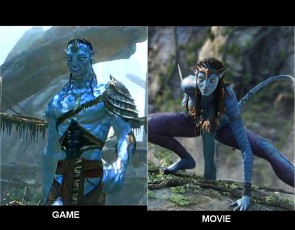
Q. One of your big points is that it provides more detail and more utility than polygons. What is your reasoning behind this?
“In a polygon game the computer will take time to process each polygon, so if you have more polygons on screen then you need a faster processor. If we look at games today, we see many areas where things don’t look realistic (of course unlimited detail in its tech demo form doesn’t look realistic either, that will come when we begin importing laser scanned point cloud data models). The polygon count has been slowly increasing as better hardware is made, but if you look at Avatar the game and Avatar the movie we still see a huge difference. Unlimited Detail jumps over a few decades of hardware development by giving us unlimited geometry today.
Regarding utility, polygons are difficult things to work with, for example; every object the artist makes must be built to a strict polygon budget. They often want to make a more beautiful object but they are simply not allowed to. Once the object is made they must begin the task of rebuilding downscaled distance models. The distance model system works by having models of different sizes for different distances, if an object is far away you only want to use a simple 8 polygon tree, if it’s close then you want a high polygon count model. Models are rebuilt four-eight times depending on the game, the first few models can be downscaled with computer assistance and markers placed, but after that they must be rebuilt by hand. Unlimited Detail has freed the developer from all these issues.”
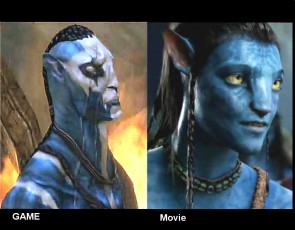
Q. While reading up on different websites around the internet, I found a few people saying that developers are simply more comfortable with polygons. Do you agree with this? Are developers simply not ready to transition out of their safe zone?
“I understand such mentality, my grandmother was delighted before Y2K (year 2000 computer crash) she thought that it would end all technology and we would have to go back to the horse and buggy, it is normal for people to want to hold on to the good old days. I saw monkeys on David Attenborough cracking nuts with rocks, and he went on to explain that the young ones learned it easily but most of the old ones could not progress to learn this new trick. I am glad to say that the majority of companies we correspond with do not hold on to the past with both hands. We have been contacted by many developers eager to licence Unlimited Detail when completed. Please understand, we aren’t about to tell the industry to leave polygon editors and all move to point cloud data editors, there is no problem with building your graphics on maya at the highest settings then converting to point cloud data, to the developer he still feels like he is using polygons, the difference is they now have unlimited amounts of them. Put yourself in the developer’s shoes for a minute and see things from their perspective.
If you make a game without UD and your opposition makes a game with UD then firstly the UD game looks better (no angular sides and laser scanned real world objects) you know the UD game was cheaper to make (artists didn’t distance model, and a lot of art was bought cheaply from CGI libraries) but the biggest blow is that you built your non UD polygon game for a PS3 and so your models are big and they aren’t going to run on a Wii or a PSP or most other systems so you sell your one game on one platform (or at best you also do a PC release for those who have the latest graphics card). Alternatively, your Unlimited Detail using rival company presses a button and all his graphics rescale (point cloud data rescales as easily as a bitmap image on paint) and so he releases his game on all consoles and can even release it on PCs with no graphics card in the developing world (China, India, Russia, South America, the largest market on earth), so you see him make 10 times more sales than you. As much as the focus of Unlimited Detail is graphics it will be the universal scalability (even down to mobile phones) that will be most in the developers mind, as well as the huge artistic cost savings.”
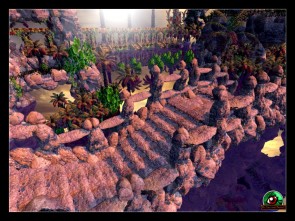
Q. In your picture gallery I saw the jungle picture and the reflections in the water. Needless to say I was simply amazed at the detail. Was that something easy to achieve with your technology?
“Id love to say we did some trick but truth is I just made them all blue and turned them upside down. If it was a polygon game that would have doubled our polygon count and made us twice as slow, but for UD, volume doesn’t equal speed so it was a cheap trick. We have built real water reflections since then. “
Q. What are some of the trials and errors you have faced through the development process of this technology so far?
“When trying to build a search algorithm that scans 3D atoms your biggest problems are what do you grab when they are far away and small ? How do you know whether an object is blocked by another object ? In the end perfect solutions were found. I don’t use the word perfect lightly, for a long time I was not at all happy with some parts of the system but they kept evolving and now we are at the point were the core of our algorithm is less then two pages long and it has no multiplication or division (multiply and divide slow a computer down). Our claim is we have reached the point where it’s so small and efficient it can’t be improved upon. Often in maths you reach the point of perfection from which there can be no improvement. Consider Pythagoras, there are longer ways to find the area of a circle, but he found the perfect way on which there can be no improvement. Likewise, time will be our judge, but in the future when UD is taught in universities it maybe held as the highest and best way to process 3D. I personally like UD because it’s so simple and “pure” .
If you were an unkind person you could say the polygon system looks like a ship that is sinking but it got patched up with straw. It’s wasteful, so distance modelling must be used. It can’t do complex texture, so advanced displacement maps are added. It doesn’t scale well in to the distance so maths correction programs are installed. Grass fades and disappears if it’s too far from the camera, objects pop in and out, every thing is hollow like an easter egg, it’s a system of “tricks” that have a nice result by brute force and masses of work most of which is inefficient. It was great for hallway games like Doom, but we use it now to make trees and forests and ideally it was never meant to be used in such a manner. If you were a more generous person the truth is Polygons have been great. They served us well, and we should be grateful for all the work the people involved did to bring us twelve years of great 3D games. They aren’t about to leave us completely and they may not be the best solution for real time graphics any more, but they are still a great modelling tool and are likely to remain so.”
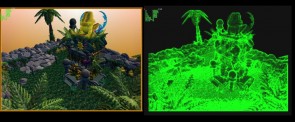
Q. You are the Chief Executive officer of the operation. What are some of your responsibilities?
“I do all the “chatting” with developers and laser scanner companies, the media and everyone else who needs chatting to. I’m also the original inventor and joint project leader and I also do some R&D in to new technology for the distant future.”
Q. Greg Douglas is the Chief Technology Officer. Can you tell us what he does for the operation?
“He is [the] joint project leader, he also handles some areas that I can’t, like compatibility with graphics cards and polygon to point cloud conversion.”
Q. Are you and Mr. Douglas the only people working on this project, or are there other people behind the scenes?
“We were but after investor involvement we now go between six-ten people depending on what sub part we are working on.”
Q. What exactly is point cloud data, and how does it work?
“Think little 3D atoms, X, Y, Z and some property coordinates, like colour and texture. However we store it all in a zipped format that recycles any common structures. So it’s all nice and small in the end.”
Q. In Figure 1.5 the amount of objects on screen and the detail that is involved was astounding. Is this something that would become commonplace if your technology were utilized at the next level?
“I have been told on one or two occasions “your pictures are too crowded”, so such levels of detail are not always desired by everyone, but if you want to have such detail it’s now available.”
Q. When you say “unlimited geometry” what exactly does that mean?
“Good question. I think some think we mean unlimited computer memory, we certainly don’t mean that. Computer memory isn’t an issue it’s so cheap these days and it gets cheaper all the time. We mean we can show unlimited volumes of objects on the screen. Normally if you have a polygon tree on the screen and you add a second tree the computer will be twice as slow, with Unlimited Detail you can put as many trees as you like and it will run just fine. In a way its like having unlimited processing power (very loosely speaking).”
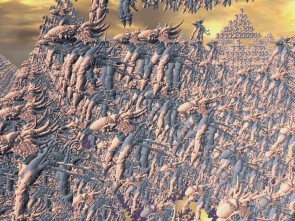
Q. On your site, it says that this technology should be more mainstream in about sixteen months. Is that still the plan?
“Let’s say we’ll be done in two years, that way we can finish it in one and you’ll all think we were quick.
However we intend to release real time .exe demos long before completion. (No, I cant say when.)”
Q. To anyone else developing new technology for the industry, what would you say to them?
“Give it up and go cook fish and chips instead, (kidding). It’s very hard, the tech people are the ones who do the assessment in these companies and if you have a huge leap in technology then basically they are being asked to cause problems for their careers. Imagine if you are a polygon expert who spent eight years in uni, the whole company loves you, because you have boosted polygon efficiency by 18%, then they ask you to asses whether polygons are no longer needed. A ray trace expert who poured his life in to ray tracing, then Unlimited Detail comes along and it’s 200 times quicker. The idea that if you invent something better then they will all come knocking on your door with bags of money just isn’t true. The only way a big company will pay enough attention is by you becoming a financial threat to them. I’ve had senior levels of graphics card producers tell me that “ We have enough polygons and nobody needs or are in want of more.” (that was six years ago) of course my reply was “Well then shouldn’t you stop building better graphics cards?”

I’ve had heads of departments from games console companies work really hard to tell their company why are we building a core processor that doesn’t give them ten times more power we have promised when we can rip the thing out and just use Unlimited Detail in software. I’ve watched CPU designers move in to graphics, plan to release an amazing system which turns out to be a failure because the idea of swapping 450 years of man research for 12 pages of code from Australia is one that the tech people hope never end up in front of the board of directors. Big companies are like big ships, turning them around is a long slow process, little companies are like little boats and they can turn around and change course easily. Games developers are a cheery bunch and it’s always positive there because they use the 3D system, but try to get the people who make the 3D system to upgrade and you’ll eventually realize the only path forward is to do it yourself.”
-(Special Thanks to Mr. Chris Warris (Quipster99 of Youtube) for providing me with the means to contact Mr. Dell)-
Feature Type: Interviews | Tagged Bruce, Dell, Detail, Jacob, Roberts, Saylor, Technology, Unlimited


